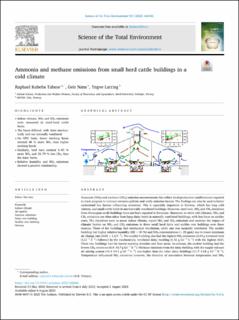Ammonia and methane emissions from small herd cattle buildings in a cold climate
Peer reviewed, Journal article
Published version

Åpne
Permanent lenke
https://hdl.handle.net/11250/3123415Utgivelsesdato
2023Metadata
Vis full innførselSamlinger
Originalversjon
Tabase, R. K., Næss, G. & Larring, Y. (2023). Ammonia and methane emissions from small herd cattle buildings in a cold climate. Science of the Total Environment. 903. doi: 10.1016/j.scitotenv.2023.166046Sammendrag
Ammonia (NH3) and methane (CH4) emission measurements that reflect local production conditions are required to track progress in national emission policies and verify emission factors. The findings can also be used to better understand key factors influencing emissions. This is especially important in Norway, which has long cold winters, and small cattle herds in mechanically ventilated buildings. However, until now, NH3 and CH4 emissions from Norwegian cattle buildings have not been reported in literature. Moreover, in other cold climates, NH3 and CH4 emissions are often taken from large dairy herds in naturally ventilated buildings, with less focus on suckler cows. The objectives were to assess indoor climate, report NH3 and CH4 emissions and examine the impact of climatic factors on NH3 and CH4 emissions in three small herd dairy and suckler cow buildings over three seasons. Three of the buildings had mechanical ventilation, while one was naturally ventilated. The suckler building had higher relative humidity (RH > 90 %) and NH3 concentrations (> 25 ppm) due to lower minimum air change rate (ACH = 1.2 h−1). The suckler building also had the highest NH3 emissions (2.04 g Livestock Unit (LU)−1 h−1) followed by the mechanically ventilated dairy building (1.92 g LU−1 h−1) with the highest ACH. These two buildings had the lowest stocking densities and floor areas. In contrast, the suckler building had the lowest CH4 emissions (6.8–10.7 g LU−1 h−1). Methane emissions from the dairy building with the supply-exhaust air mixing system (16.4–19.3 g LU−1 h−1) was higher than the other dairy buildings (11.7–13.8 g LU−1 h−1). Temperature influenced NH3 emissions however, the direction of association between temperature and NH3 emissions differed among buildings. Relationship between RH and NH3 emissions was positive, but the correlation coefficient (R2 = 0.67) was strongest in the building with the highest RH.
